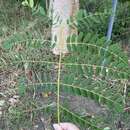en
names in breadcrumbs


Albizia proceraor White Siris is a member of the sub-family Mimosaceae (Azad, Biswas & Matin, 2012: 124).Albizia procerais an early successional tree and is found in dry tropical forests in India (Khurana & Singh, 2000: 1185) and native to semi-evergreen hill forests and in lowland savanna woodlands in Bangladesh, Nepal, Pakistan, Thailand (reviewed in Azad, Biswas & Matin, 2012: 124; Parrotta, 1997). It is only found in Florida and Puerto Rico, in the United States and also in Thailand, Vietnam, Philippines, Indonesia, and China (reviewed in Azad, Biswas & Matin, 2012: 124; Nature Serve, 2015). Albizia proceraoccurs also in tropical semi-evergreens, moist deciduous and northern subtropical, broad leaved, forests (reviewed in Khurana & Singh, 2000: 1185). This species grows best on very moist, alluvial sites of well-drained loams or clays but can also tolerate shallow, dry, stony, and sandy soils, and alkaline and saline soils (Khurana & Singh, 2000: 1185; Parrotta, 1987: 282).Albizia procerais harvested for timber and fodder (Azad, Biswas & Matin, 2012: 125). Conservation status is not yet ranked (Nature Serve; 2015).
Albizia proceracan reach a height that is ten to twenty meters in height and thirty to sixty centimeters in width (Parrotta, 2000: 282). Depending on conditions, it can grow 1 to 2 meter annually and annual diameter growth is 1.5 to 2 centimeters for the first 15 years of life(Parrotta, 2000: 282).
The flowers form whitish globose heads that are 20-24 mm in diameter, borne on the racemes that are 8-25 cm long (Parrotta, 1987: 282).Albizia procera flowers during the rainy season of the year, between May-September in Florida, and between August and October in Puerto Rico. Flowering of these plants begins at ages 3 to 4, when trees are a height of about 4 meters (Parrotta, 1987: 125).
The fruits are flattened pods that are 10-20 cm in length and ripen to a deep, reddish brown. The fruits ripen 6-9 months after flowering (Parrotta, 1987: 282). Seeds are a dark reddish brown color, with an elliptical shape (Azad, Biswas & Matin, 2012: 126). Seedlings from larger seeds were found to have larger leaf area and were also more tolerant of extreme water stress, and seedlings from smaller seeds were found to be tolerant of moderate water stress (Khurana & Singh, 2000: 1186).
Albizia procera, commonly known as white siris or karoi tree, is a species of large tree found natively in southeast Asia and India. It is most commonly found in open forests, but may also be found on the margins of rain forests and in monsoon and gallery forests.[2] It is considered an invasive species in South Africa.[3]
The genus name Albizia honors the Florentine naturalist Filippo del Albizzi, while the species name is derived from the Latin word 'procerus', meaning 'very tall or high'.[4]
A. procera is typically between 7 and 15 meters tall, although occasionally it reaches 30 meters in height.[3] It is deciduous, going leafless in the dry season (August–September).[2] The leaves are bi-pinnate, with 2–5 pairs of sub-opposite pinnae and a 10–30 centimeter rachis.[4] The bark is smooth and light-colored, exfoliating to reveal a reddish color underneath.[5] It produces sessile greenish-yellow flowers with long, threadlike white stamens, creating a puffball effect; these are borne on racemes 8–25 centimeters long.[6] The flowers give way to rich red or reddish-brown flattened pods containing 6–12 small, greenish-brown seeds.[7]
A. procera is cultivated for timber or as fuel in Asia, Africa and the Americas.[8] In India, the leaves are considered good fodder for animals such as cows, sheep, goats, and elephants.[7] The wood makes good charcoal, and the resin is a good substitute for gum arabic.[9] The leaves are said to be insecticidal, while the bark may be used to make fish poison.[10]
Albizia procera, commonly known as white siris or karoi tree, is a species of large tree found natively in southeast Asia and India. It is most commonly found in open forests, but may also be found on the margins of rain forests and in monsoon and gallery forests. It is considered an invasive species in South Africa.
The genus name Albizia honors the Florentine naturalist Filippo del Albizzi, while the species name is derived from the Latin word 'procerus', meaning 'very tall or high'.